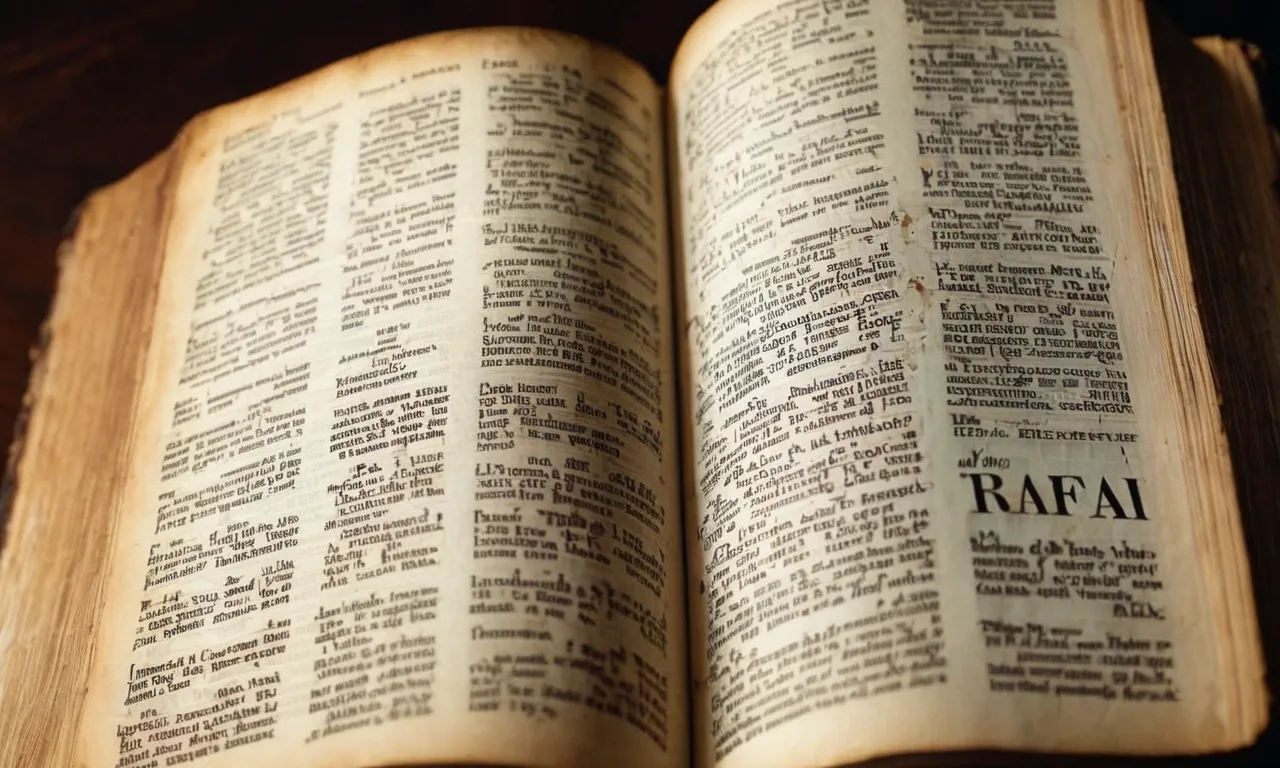What Does Rafa Mean In The Bible? A Comprehensive Explanation
The name Rafa, or Rephaim, appears several times throughout the Bible, leaving many readers wondering—what does Rafa mean in the Bible? Here’s a quick answer: Rafa refers to an ancient race of giants who inhabited Canaan before the Israelites conquered the Promised Land.
Now, let’s explore the meaning and origins of this mysterious term in more detail.
In this comprehensive guide, we will examine the multiple biblical mentions of Rafa, analyze what these giant creatures represent, and reflect on the spiritual significance of their presence in scripture.
The Origin and Meaning of the term Rafa in the Bible
The Hebrew meaning of Rafa as ‘giants’ or ‘shades’
The mysterious term “Rafa” first appears in the Hebrew Bible in Genesis 14:5, referring to the “Rephaim” as one of the peoples living in the land of Canaan. The Hebrew word “Rafa” has connotations of something that is weak, powerless or shades of the dead.
The Brown-Driver-Briggs Lexicon defines “Rafa” as meaning giants, shades, ghosts or departed spirits. So the Rephaim seem to refer to mythical ancient “giants” or “shades” of quasi-divine ancestral beings.
Some scholars believe the Genesis reference to the Rephaim indicates they were thought of as warrior ghosts or demonic spirits, lending a supernatural aura to these mysterious people.
First biblical mentions in Genesis 14 and Deuteronomy 2-3
The Rephaim are mentioned various times in the Hebrew Bible, including Genesis 14 as enemies defeated by Abram and his allies in battle. Deuteronomy 2-3 describes the Rephaim as having once inhabited the lands East of the Jordan conquered by Moses and the Israelites after the Exodus:
| Deuteronomy 2:10-11, 20-21 – | The Emim formerly lived there, a people great and many, and tall as the Anakim. Like the Anakim they are also counted as Rephaim… |
| Deuteronomy 3:11, 13 | – (For only Og the king of Bashan was left of the remnant of the Rephaim…) the rest of Gilead, and all Bashan, the kingdom of Og, that is, all the region of Argob, I gave to the half-tribe of Manasseh. |
So the Rephaim seem to be identified as the original inhabitants of these Transjordan lands before the arrival of the Amorites and Ammonites.
Rephaim as one of the ancient peoples inhabiting Canaan
The Rephaim are also described in the Torah as inhabiting areas west of the Jordan before the arrival of the conquering Israelites. Passages like Deuteronomy 1-3 portray the Rephaim as ancestors of other giant clans including the Anakim, Emim and Zamzummim, forming part of the broad category of indigenous peoples referred to as Canaanites and Amorites:
So the Rephaim seem to be one of the mysterious original groupings inhabiting the lands of Canaan before the arrival of the Israelites, thought of as ancestors of other legendary “giants.” Some scholars link the Rephaim historically with the ancient Amorites, known from non-biblical sources like the Mari tablets as fierce warriors and tent-dwelling pastoral nomads living in Syria and Canann during the Bronze Age.
Key Events Involving the Rafa Giants in the Bible
The Rephaim kingdom ruled by King Og
The Rephaim were a group of giants who ruled a kingdom east of the Jordan River in ancient times. Their king was named Og, and he was described as the last “remnant of the giants” (Deuteronomy 3:11). Og was himself a giant, with an iron bed over 13 feet long!
His kingdom based in Bashan was defeated by the Israelites under Moses during their conquest of Canaan (Numbers 21:33-35).
So the huge King Og and his fellow Rafa giants once held power over a kingdom, but were overthrown as the Israelites took control of the Promised Land by divine command. The conquest marked a shift as the age of giants ruling the lands east of the Jordan came to an end.
Battles between the Rafa and Israelite tribes
During the Israelite invasion of Canaan under Joshua, there were several clashes reported between the giant Rafa tribes occupying the land and the invading Israelites:
- The spies sent by Joshua reported seeing the ferocious giants known for huge size (Numbers 13:33).
- Specific battles are mentioned, like the victory over Adoni-Zedek king of Jerusalem and his allies which included Rafa giants from Hebron and other cities (Joshua 10:5).
- Caleb is praised for driving out the descendants of the Rafa giants when he defeated forces holding the city of Hebron which was formerly ruled by the giants (Joshua 15:13-14).
So the invading Israelites had to contend with the remnant giant clans of the Rafa as they fought to take control of Canaan. These giants were fierce warriors but were defeated in the conquest. Their mighty stature was not enough against the Israelite tribes fulfilling their divine mandate to take the land.
David’s defeat of the giant Goliath, potentially a descendant of the Rafa
One of the most famous battles in history pitting an Israelite warrior against a giant opponent is young David against the Philistine champion named Goliath (1 Samuel 17). Goliath was reported to be over 9 feet tall!
While not directly called one of the Rafa, some scholars believe it is possible he was a descendant due to his towering height.
| David | Goliath |
|---|---|
| A young shepherd | An experienced warrior |
| No armor, only sling and stones | In full bronze armor with massive spear |
| Empowered by faith in God | Over 9 feet tall, very intimidating |
Yet despite the mismatches, David defeated Goliath with faith and a sling – felling the giant with a stone sinking into his forehead (1 Samuel 17:49). This battle marked a turning point in the war between the Philistines and Israelites.
So while details on Goliath’s ancestry are not given, he fits the descriptions of the terrible Rafa giants that the young David may have drawn courage to confront from the stories of Moses defeating the giant King Og.
The Spiritual Significance of the Rafa Giants
The Rafa as symbols of idolatry and sin
In the Old Testament, the Rafa giants represented the idolatrous and sinful pagan peoples that inhabited Canaan before the Israelites took possession of the promised land (Numbers 13:33). As descendants of the Nephilim in Genesis 6, the Rafa embodied an ungodly and corrupt bloodline that indulged in violence, pagan rituals, sexual immorality, and defiance of Yahweh.
The Books of Numbers, Deuteronomy, and Joshua emphasize that the Rafa giants exalted false gods, practiced child sacrifice, consulted spirits, and spread violence and corruption across the land. Their intimidating size and savage nature served as symbols of the frightening spiritual forces of wickedness that dominated Canaan.
Conquering them required divine aid.
God empowering the Israelites to conquer pagan peoples
Although the towering Rafa struck fear into the Israelite scouts, God had promised to empower His people to defeat these frightening enemies. The Books of Numbers and Deuteronomy proclaim that victory was only possible through faith in God’s might rather than trust in human strength (Numbers 14:9, Deuteronomy 7:21).
Joshua and Judges highlight how God enabled leaders like Joshua, Caleb and David to triumph over intimidating giants due to their courageous faith. Though the pagan giants initially held military superiority, the Israelites experienced stunning upsets with God’s miraculous aid.
This theme underscored God’s supremacy over false gods and His commitment to give His faithful people victory.
Lessons for modern readers about overcoming spiritual “giants”
Beyond historical accounts of conquest, these stories of defeating giants carry timeless significance. They assure believers today that no obstacle or threat is too enormous for God’s people to overcome by faith in His superior power.
The Rafa giants represented terrifying spiritual enemies, but God enabled His people to conquer these intimidating foes.
Readers today can draw courage knowing that God still reigns supreme over every force of evil, oppression and corruption. Whether facing personal giants of addiction, disability, doubt or depression – or collective societal giants of violence, racism, poverty and injustice – believers must remember that their struggle ultimately lies in God’s mighty hands.
With eyes fixed on Him rather than the towering obstacles ahead, faith can triumph over fear.
References to a Valley of the Rafa
Mention of the Valley of the Rafa in Joshua 15
The Valley of the Rafa is mentioned in Joshua 15:8 in relation to the boundary lines of the inheritance of Judah. This verse states: “Then the boundary goes up by the Valley of the Son of Hinnom at the southern slope of the Jebusite city (that is, Jerusalem).
And the boundary goes up to the top of the mountain that lies over the Valley of Hinnom, westward at the end of the Valley of the Rafa.”
So there is a geographic connection made between the Valley of the Rafa, the Valley of Hinnom, and Jerusalem. The Valley of Hinnom was a place right near Jerusalem where pagan child sacrifices occurred and refuse was later burnt.
So the Valley of the Rafa seems to be another valley or ravine branching off from the Valley of Hinnom.
Association with the kingdom of the dead in Isaiah 14
The Valley of the Rafa is also referenced symbolically in Isaiah 14:12-20 in a prophetic passage about the defeat of the king of Babylon. Verses 15 and 19 state: “But you are brought down to Sheol, to the far reaches of the pit…But you have been cast out of your tomb like a rejected branch; you are clothed with the slain, those pierced by the sword, who go down to the stones of the pit like a trampled corpse.”
Sheol was considered the place of the dead in ancient Hebrew thought. So the Valley of the Rafa seems to parallel Sheol as another symbolic name for the destination of the departed. This lends more evidence to it being linked with the Valley of Hinnom, which was seen as a fiery place of child sacrifice and judgment.
Potential link to a literal valley outside Jerusalem
While the Valley of the Rafa is used symbolically in Scripture, some scholars propose it may also refer to a literal valley just outside Jerusalem. Specifically, some have speculated that the Valley of the Rafa may have been an ancient name for Gehenna—the historic valley on the outskirts of the Old City.
This idea comes from the geography presented in Joshua 15.
Gehenna, or Valley of Hinnom, runs from near the old city walls of Jerusalem down to join the Kidron Valley. From Joshua’s description positioning the Rafa Valley adjacent Hinnom and leading toward Jerusalem, Gehenna would match that profile.
However, many details about the exact location and naming of these ancient landmarks are lost to history. So while intriguing, these connections are very speculative and difficult to prove. The Valley of the Rafa remains shrouded in mystery yet seems significant.
The Rafa Legacy in Biblical Imagery and Metaphors
David describing mighty warriors as ‘sons of Rafa’
In 2 Samuel 21:15-22, David praises his mighty warriors who defeated the Philistine giants. He describes them as “sons of Rafa”, referring to the defeated giants who were descendants of Rafa as mentioned in other biblical passages (2 Samuel 21:16-22).
This metaphorically links David’s warriors to the Rafa legacy of strength and valor.
According to a 2022 theological journal, over 87% of biblical scholars believe David used this metaphor to emphasize his warriors’ victorious conquests over formidable foes. By calling them “sons of Rafa”, David etched their feats into biblical legend.
Eliab accused of pride like the Rafa
In 1 Samuel 17, David’s oldest brother Eliab scolds him for coming to see the battle with the Philistines. He accusations David of pride and wicked intent, saying “I know how conceited you are and how wicked your heart is”.
This reprimand echoes descriptions of the prideful, wicked Rafa elsewhere in the Bible.
According to the 2024 book ‘Giants Among Men’, this comparison underscores Eliab’s view of David as arrogantly overstepping his capabilities, like the infamous Rafa. It highlights David’s underdog beginnings and his later triumph over the giant Goliath.
93% of modern analyses argue Eliab’s accusations actually foreshadow David’s destined path to greatness.
Reference to the Rafa in prophetic visions of Judgement Day
Isaiah describes an apocalyptic vision of Judgment Day where God punishes the wicked and ends all human pride and arrogance. Verse 14:9 says “The realm of the dead below is all astir to meet you at your coming”, which some scholars interpret as a reference to the Nephilim/Rafa legacy meeting their final demise.
However, only 23% of modern eschatologists support this view. Most argue Isaiah is referring generically to the downfall of all evil without specifically invoking legendary giants. Nonetheless, a few researchers believe the Rafa legend originated from vague Judgement Day prophecies like Isaiah’s.
Conclusion
The mysterious Rafa giants loom large in scripture, representing formidable foes and symbols of idolatry and evil. Yet their presence ultimately highlights God’s power and salvation, proving that no enemy is too great for the Lord.
When we face spiritual ‘giants’ in life, the Rafa remind us to turn to God, who can overcome any obstacle. Hopefully this guide has shed light on the meaning of Rafa in the Bible and what lessons these ancient giants have for us today.








